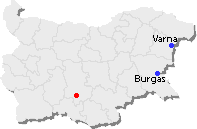
The Bachkovo Monastery is the second biggest monastery in Bulgaria after the Rila Monastery. It is picturesquely surrounded by the Rhodope hills which together with its imposing dimensions and authenticity make it one of the most visited monasteries in Bulgaria.
In 1083 the sebast and great ruler of the West (i.e. the Balkan peninsula) the Georgian – Grigoriy Bakuriyani together with his brother Abraziy were the ones that endowed enormous money and property to build a monastery in the narrow part of Chaya River, just above Asenovgrad town. Eversince the monastery foundation Grigoriy had signed a certificate by which he wanted not only to regulate the property and life of he monks but also to holdback the Greek clergy attempt to take possession of the monastery. The certificate said that the monastery is owned by georgian people and only the clerk can be of byzantine origin.
Three years later Bakuriyani died in a battle against the pechenegs but his will was kept and the monastery remained georgian property till XII C. In the next years the monastery became known as an important geogrian-greek cultural center. One of the writers that had worked there was the famous georgian phylosopher- neoplatonian John Petrisi (1050-1130).
The Bone Vault is the only building preserved till today, witness of how the old monastery once looked. It is a two-storey building where the first floor is the feretory and the second floor – the chapel. There are fourteen built-in graves in the feretory floor which show that the Bone Vault was made to meet the needs of the Bakuriyani family.
In 1199 the Plovdiv region and the Middle part of the Rhodopes were again included in the revived Bulgarian state of the Asen dynasty. It seems the monastery gradually changed hands and in the next decades it became bulgarian property. Despite that the georgian influence lasted till XIV C.
The Bachkovo Monastery remained in the territory of the Bulgarian state till 1364 when Plovdiv town and the neighbouring Rhodope strongholds were invaded by the Ottomans. After Tarnovo town fell to the Turks the last bulgarian patriarch and well-known writer Patriarch Evtimji was sent into exile to the Monastery. That did not discourage him and together with his students he developed religious and educational activities behind the monastery walls.
In the XV C. the monastery was burned down by the Turks. It’s revival began around 1600 when the south wings and the new cathedral were built.
The monastery preserved its first apperance till the beginning of our century when the west wing and the building broke down.
In the XIX C. the monastery became so famous in the Trakia region that it’s old mediaeval corpuses could hardly house all the pilgrims. Therefore in 1833 the small farm yard close to the south wings was enlarged and two-storey guest-houses were added to the monastery complex. The base floor of these houses included the cattle-shed and the upper floor – the guest rooms. The buildings in the yard burnt in the fire in 1947 but during the 80-ies they were restored as per the project of the architects Nikola Mushanov and Zlatka Kirova.
In 1834 and 1837 the Abbot - monk named Anani of bulgarian origin , that came from the town of Sliven helped for the building of a new church in the worship yard. Thus the churches in the complex became three and more pilgrims could play there.
Many masterpieces are kept in the Bachkovo monastery such as fine wallpaintings, woodcarvings, icons and church inventory. The Bone Vault (the Cemetery church) with its unique frescoes, dated back to its foundation, is preserved till nowadays. An inscription with the name of the georgian painter Joan Iveropulets, who decorated the church, are kept on the base floor. It was performed following the classical mediaeval painting techniques in the typical buznatine style of the XI -XII C. which makes it one of the most exquisite architectural monuments of the Orthodox art.
The monastery is decorated with many woodcarvings best example ot which is one stand of a table from the XVI and XVII C. The woodcarved structure of the golden iconostasis of the King Gates of the main church date back to XVII C. Its performance show great simplicity and finess in one. Except the main church the complex included also two smaller temples – the “St Archanges” (XII-XIV C) situated in the north yard, close to the main church and the “St. Nicolas” which was built in 1834-1837. The “St. Nicolas” church rises in the south part of the church yard and attracts with its well-preserved frescoes from 1841, painted by the famous master Zachari Zograf. There among the numerous figures the Master depicted himself too.
The monastery has its own museum where ritual object of different historical periods are exhibited.















